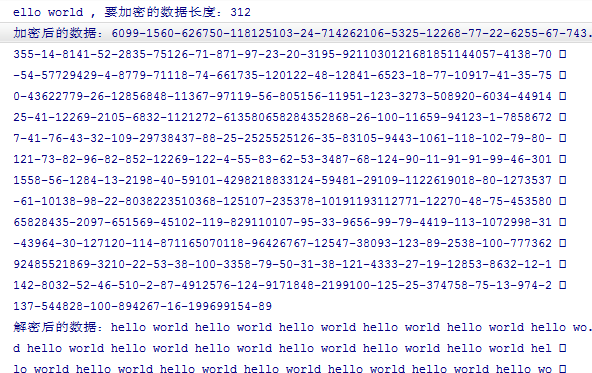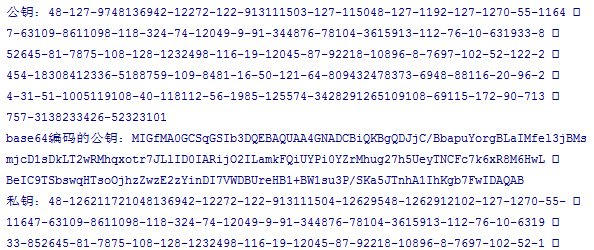Android使用RSA加密和解密的示例代码
一、公钥加密和私钥解密
/**RSA算法*/
public static final String RSA = "RSA";
/**加密方式,android的*/
// public static final String TRANSFORMATION = "RSA/None/NoPadding";
/**加密方式,标准jdk的*/
public static final String TRANSFORMATION = "RSA/None/PKCS1Padding";
/** 使用公钥加密 */
public static byte[] encryptByPublicKey(byte[] data, byte[] publicKey) throws Exception {
// 得到公钥对象
X509EncodedKeySpec keySpec = new X509EncodedKeySpec(publicKey);
KeyFactory keyFactory = KeyFactory.getInstance("RSA");
PublicKey pubKey = keyFactory.generatePublic(keySpec);
// 加密数据
Cipher cp = Cipher.getInstance(TRANSFORMATION);
cp.init(Cipher.ENCRYPT_MODE, pubKey);
return cp.doFinal(data);
}
/** 使用私钥解密 */
public static byte[] decryptByPrivateKey(byte[] encrypted, byte[] privateKey) throws Exception {
// 得到私钥对象
PKCS8EncodedKeySpec keySpec = new PKCS8EncodedKeySpec(privateKey);
KeyFactory kf = KeyFactory.getInstance(RSA);
PrivateKey keyPrivate = kf.generatePrivate(keySpec);
// 解密数据
Cipher cp = Cipher.getInstance(TRANSFORMATION);
cp.init(Cipher.DECRYPT_MODE, keyPrivate);
byte[] arr = cp.doFinal(encrypted);
return arr;
}
1.data是要加密的数据,如果是字符串则getBytes。publicKey是公钥,privateKey是私钥。自定义密钥对测试
String data = "hello world";
try {
int keyLength = 1024;
//生成密钥对
KeyPair keyPair = RSAUtils.generateRSAKeyPair(keyLength);
//获取公钥
byte[] publicKey = RSAUtils.getPublicKey(keyPair);
//获取私钥
byte[] privateKey = RSAUtils.getPrivateKey(keyPair);
//用公钥加密
byte[] encrypt = RSAUtils.encryptByPublicKey(data.getBytes(), publicKey);
Log.d("TAG", "加密后的数据:" + StringUtils.byteArrayToString(encrypt));
//用私钥解密
byte[] decrypt = RSAUtils.decryptByPrivateKey(encrypt, privateKey);
Log.d("TAG", "解密后的数据:" + new String(decrypt, "utf-8"));
} catch (Exception e) {
e.printStackTrace();
}

2.从文件中读取公钥

String data = "hello world";
//读取公钥文件
String publicKeyString = IOUtils.readAssetsFile(this, "rsa_public_key.pem");
//base64解码
byte[] publicKey = Base64Utils.decodeToBytes(publicKeyString);
try {
//加密
byte[] encrypt = RSAUtils.encryptByPublicKey(data.getBytes(), publicKey);
Log.d("TAG", "加密后的数据:" + StringUtils.byteArrayToString(encrypt));
// //读取私钥文件
// String privateKeyString = IOUtils.readAssetsFile(this, "rsa_private_key.pem");
// //base64解码
// byte[] privateKey = Base64Utils.decodeToBytes(privateKeyString);
// //解密
// byte[] decrypt = RSAUtils.decryptByPrivateKey(encrypt, privateKey);
// Log.d("TAG", "解密后的数据:" + new String(decrypt, "utf-8"));
} catch (Exception e) {
e.printStackTrace();
}
二、公钥分段加密和私钥分段解密
当加密的数据过长时,会出现javax.crypto.IllegalBlockSizeException: Data must not be longer than 117 bytes的异常。rsa算法规定一次加密的数据不能超过生成密钥对时的keyLength/8-11,keyLength一般是1024个字节,则加密的数据不能超过117个字节
/**秘钥默认长度*/
public static final int DEFAULT_KEY_SIZE = 1024;
/**加密的数据最大的字节数,即117个字节*/
public static final int DEFAULT_BUFFERSIZE = (DEFAULT_KEY_SIZE / 8) - 11;
/**当加密的数据超过DEFAULT_BUFFERSIZE,则使用分段加密*/
public static final byte[] DEFAULT_SPLIT = "#PART#".getBytes();
/** 使用公钥分段加密 */
public static byte[] encryptByPublicKeyForSpilt(byte[] data, byte[] publicKey) throws Exception{
int dataLen = data.length;
if (dataLen <= DEFAULT_BUFFERSIZE) {
return encryptByPublicKey(data, publicKey);
}
List<Byte> allBytes = new ArrayList<Byte>(2048);
int bufIndex = 0;
int subDataLoop = 0;
byte[] buf = new byte[DEFAULT_BUFFERSIZE];
for (int i = 0; i < dataLen; i++) {
buf[bufIndex] = data[i];
if (++bufIndex == DEFAULT_BUFFERSIZE || i == dataLen - 1) {
subDataLoop++;
if (subDataLoop != 1) {
for (byte b : DEFAULT_SPLIT) {
allBytes.add(b);
}
}
byte[] encryptBytes = encryptByPublicKey(buf, publicKey);
for (byte b : encryptBytes) {
allBytes.add(b);
}
bufIndex = 0;
if (i == dataLen - 1) {
buf = null;
} else {
buf = new byte[Math
.min(DEFAULT_BUFFERSIZE, dataLen - i - 1)];
}
}
}
byte[] bytes = new byte[allBytes.size()];
int i = 0;
for (Byte b : allBytes) {
bytes[i++] = b.byteValue();
}
return bytes;
}
/** 使用私钥分段解密 */
public static byte[] decryptByPrivateKeyForSpilt(byte[] encrypted, byte[] privateKey) throws Exception {
int splitLen = DEFAULT_SPLIT.length;
if (splitLen <= 0) {
return decryptByPrivateKey(encrypted, privateKey);
}
int dataLen = encrypted.length;
List<Byte> allBytes = new ArrayList<Byte>(1024);
int latestStartIndex = 0;
for (int i = 0; i < dataLen; i++) {
byte bt = encrypted[i];
boolean isMatchSplit = false;
if (i == dataLen - 1) {
// 到data的最后了
byte[] part = new byte[dataLen - latestStartIndex];
System.arraycopy(encrypted, latestStartIndex, part, 0, part.length);
byte[] decryptPart = decryptByPrivateKey(part, privateKey);
for (byte b : decryptPart) {
allBytes.add(b);
}
latestStartIndex = i + splitLen;
i = latestStartIndex - 1;
} else if (bt == DEFAULT_SPLIT[0]) {
// 这个是以split[0]开头
if (splitLen > 1) {
if (i + splitLen < dataLen) {
// 没有超出data的范围
for (int j = 1; j < splitLen; j++) {
if (DEFAULT_SPLIT[j] != encrypted[i + j]) {
break;
}
if (j == splitLen - 1) {
// 验证到split的最后一位,都没有break,则表明已经确认是split段
isMatchSplit = true;
}
}
}
} else {
// split只有一位,则已经匹配了
isMatchSplit = true;
}
}
if (isMatchSplit) {
byte[] part = new byte[i - latestStartIndex];
System.arraycopy(encrypted, latestStartIndex, part, 0, part.length);
byte[] decryptPart = decryptByPrivateKey(part, privateKey);
for (byte b : decryptPart) {
allBytes.add(b);
}
latestStartIndex = i + splitLen;
i = latestStartIndex - 1;
}
}
byte[] bytes = new byte[allBytes.size()];
int i = 0;
for (Byte b : allBytes) {
bytes[i++] = b.byteValue();
}
return bytes;
}
测试分段加密和解密
String data = "hello world hello world hello world hello world hello world hello world hello world hello world " +
"hello world hello world hello world hello world hello world hello world hello world hello world hello world " +
"hello world hello world hello world hello world hello world hello world hello world hello world hello world ";
Log.d("TAG", "要加密的数据:" + data + ", 要加密的数据长度:" + data.length());
try {
//分段加密
byte[] encrypt = RSAUtils.encryptByPublicKeyForSpilt(data.getBytes(), publicKey);
Log.d("TAG", "加密后的数据:" + StringUtils.byteArrayToString(encrypt));
//分段解密
byte[] decrypt = RSAUtils.decryptByPrivateKeyForSpilt(encrypt, privateKey);
Log.d("TAG", "解密后的数据:" + new String(decrypt, "utf-8"));
} catch (Exception e) {
e.printStackTrace();
}
三、生成密钥对

/** 生成密钥对,即公钥和私钥。key长度是512-2048,一般为1024 */
public static KeyPair generateRSAKeyPair(int keyLength) throws NoSuchAlgorithmException {
KeyPairGenerator kpg = KeyPairGenerator.getInstance(RSA);
kpg.initialize(keyLength);
return kpg.genKeyPair();
}
/** 获取公钥,打印为48-12613448136942-12272-122-913111503-126115048-12...等等一长串用-拼接的数字 */
public static byte[] getPublicKey(KeyPair keyPair) {
RSAPublicKey rsaPublicKey = (RSAPublicKey) keyPair.getPublic();
return rsaPublicKey.getEncoded();
}
/** 获取私钥,同上 */
public static byte[] getPrivateKey(KeyPair keyPair) {
RSAPrivateKey rsaPrivateKey = (RSAPrivateKey) keyPair.getPrivate();
return rsaPrivateKey.getEncoded();
}
生成公钥和私钥后,用base64编码
int keyLength = 1024;
try {
//生成密钥对
KeyPair keyPair = RSAUtils.generateRSAKeyPair(keyLength);
//获取公钥
byte[] publicKey = RSAUtils.getPublicKey(keyPair);
Log.d("TAG", "公钥:" + StringUtils.byteArrayToString(publicKey));
//公钥用base64编码
String encodePublic = Base64Utils.encodeToString(publicKey);
Log.d("TAG", "base64编码的公钥:" + encodePublic);
//获取私钥
byte[] privateKey = RSAUtils.getPrivateKey(keyPair);
Log.d("TAG", "私钥:" + StringUtils.byteArrayToString(privateKey));
//私钥用base64编码
String encodePrivate = Base64Utils.encodeToString(privateKey);
Log.d("TAG", "base64编码的私钥:" + encodePrivate);
} catch (NoSuchAlgorithmException e) {
e.printStackTrace();
}

其它
一、android加密的数据服务器上无法解密?
android的rsa加密方式是RSA/ECB/NoPadding,而标准jdk是RSA/ECB/PKCS1Padding,所以加密时要设置标准jdk的加密方式
二、base64编码。因为不同的设备对字符的处理方式不同,字符有可能处理出错,不利于传输。所以先把数据做base64编码,变成可见字符,减少出错
官方提供的base64类,Base64.encode编码,Base64.decode解码。用这个会有换行符,需要自定义
三、rsa是非对称加密算法。依赖于大数计算,加密速度比des慢,通常只用于加密少量数据或密钥
四、公钥加密比私钥加密块,公钥解密比私钥解密慢。加密后的数据大概是加密前的1.5倍
以上就是本文的全部内容,希望对大家的学习有所帮助,也希望大家多多支持我们。
赞 (0)

